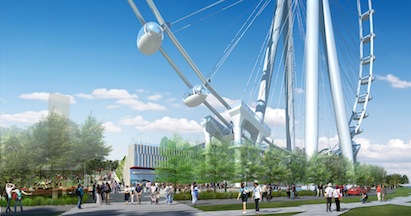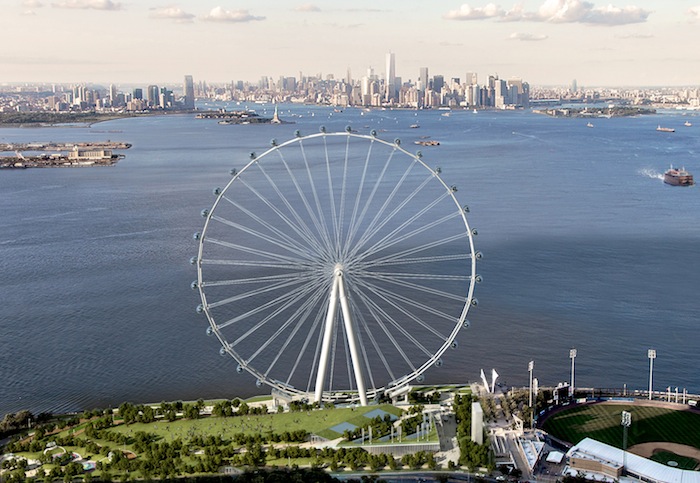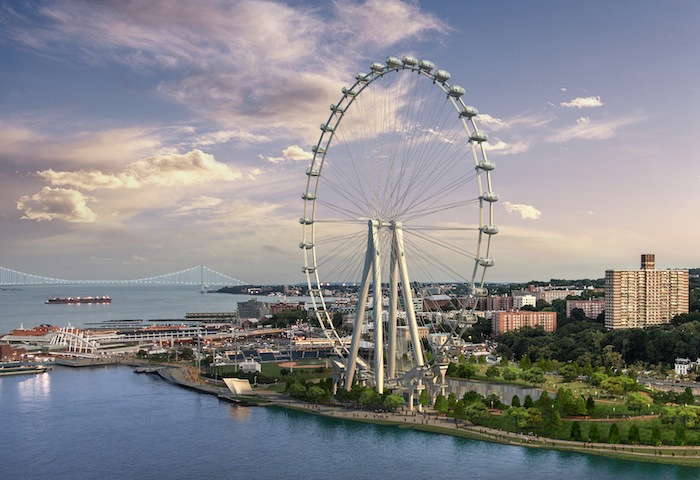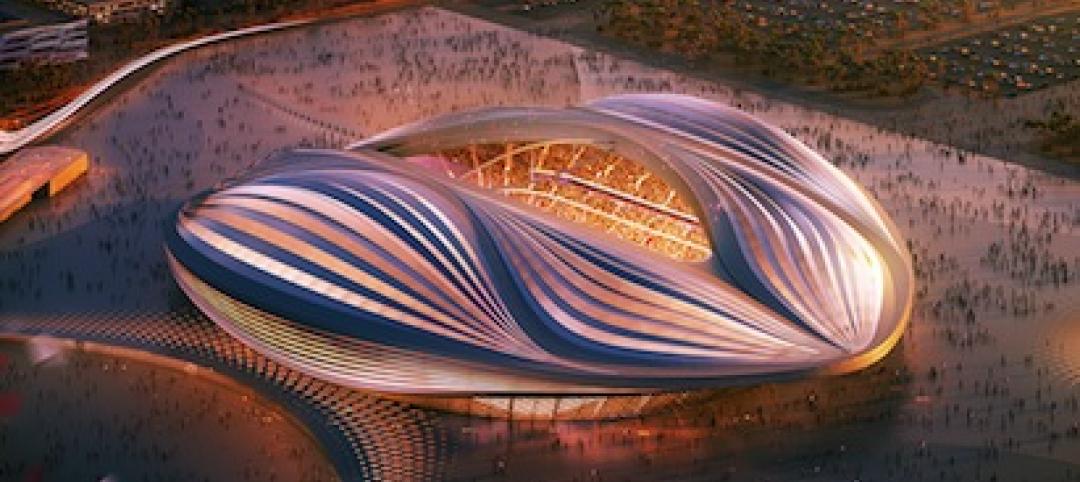The New York office of Perkins Eastman has announced that the New York Wheel, located on the north shore of Staten Island’s St. George neighborhood, was approved by City Council on October 30 and construction is scheduled to begin in 2014. The approval process has been over a year in the making since the project was first announced by the office of Mayor Bloomberg last September. Perkins Eastman is serving as design architect for the on-site 100,000 square-foot Terminal building.
Perkins Eastman will work closely with Richard Marin, CEO of New York Wheel LLC, and landscape architecture firm M. Paul Friedberg and Partners. The development will comprise retail, entertainment, dining and open space amenities amidst a compelling, integrated waterfront site that will attract millions of tourists and residents year round. Scheduled to open to the public in 2016, this currently underused shore land adjacent to the ferry terminal will become a dynamic mixed-use district. In addition to the 630-foot observation wheel, engineered by the designers of the London Eye, key components to the site will include the Terminal building, a 950-car parking garage, a bus storage facility, and an extensive landscape and sustainability program designed to provide a variety of open spaces. The Perkins Eastman design team is led by Principals Stanton Eckstut FAIA, Navid Maqami AIA, LEED AP, and Associate Principal Jonathan Cohn AIA, LEED AP.
The Terminal and its landscaped roof deck will link the water’s edge with the existing fabric of the site, offering expanses of public space for recreation, picnicking, promenade walks, cultural activities and more. “The design is intended to blur distinctions between architecture and landscape,” says Maqami, who is serving as Design Principal on the project. “The Terminal and its surrounding area will frame the iconic structure of the Wheel while providing great places that connect Richmond Terrace to the waterfront.”
While situated above grade level, the building was inspired by and designed to be part of the landscape itself, while meeting the highest standards for sustainable design and resilient waterfront development. The building’s generous interior will offer visitors clear sight lines to the Wheel, New York Harbor and beyond. Program spaces include ticketing, exhibition space, food and beverage areas, and retail opportunities. Given its proximity to the shoreline and the sustainable energy the site will draw from wind, water and sun, the Terminal building will continually devote space to educational exhibitions on alternative energy, green and resilient design, and the history of New York City, among other topics.
About Perkins Eastman
Perkins Eastman is among the top design and architecture firms in the world. With 700 employees in 13 locations around the globe, Perkins Eastman practices at every scale of the built environment. From niche buildings to complex projects that enrich whole communities, the firm’s portfolio reflects a dedication to progressive and inventive design that enhances the quality of the human experience. The firm’s portfolio includes high-end residential, commercial, hotels, retail, office buildings, and corporate interiors, to schools, hospitals, museums, senior living, and public sector facilities. Perkins Eastman provides award-winning design through its offices in North America (New York, NY; Boston, MA; Charlotte, NC; Chicago, IL; Pittsburgh, PA; San Francisco, CA; Stamford, CT; Toronto, Canada; and Washington, DC); South America (Guayaquil, Ecuador); North Africa and Middle East (Dubai, UAE); and Asia (Mumbai, India, and Shanghai, China).
About The New York Wheel LLC
The New York Wheel, located on the North Shore of Staten Island, will be the tallest observation wheel in the world and the only attraction of its kind in New York City. The 630-foot (roughly 60-story) Wheel will feature thirty-six capsules, each carrying up to 40 passengers, that will offer incomparable views of Lower and Midtown Manhattan, the Statue of Liberty, New York Harbor, and beyond both the Verrazano and the George Washington Bridges, for the duration of each 38-minute revolution. The attraction will accommodate as many as 1,440 people per trip, and will welcome as many as 30,000 visitors each day and an anticipated 4 million visitors per year.
The New York Wheel project was originally proposed in response to the New York City Economic Development Corporation’s Request for Expressions of Interest (RFEI) released in 2011 for projects that would increase economic growth, boost tourism, and create jobs on Staten Island. Meir Laufer is the founder of New York Wheel. The New York Wheel has been designed by a team from Starneth B.V., Perkins Eastman Architects and M. Paul Friedberg & Partners. It is expected to begin construction in 2014 with a grand opening scheduled for 2016. For more information about the New York Wheel visitwww.newyorkwheel.com
About M. Paul Friedberg and Partners
MPFP, LLC / M. Paul Friedberg and Partners, established in 1958, is one of the most well known and highly regarded interdisciplinary landscape architecture, urban design and planning firms in the country. Lead by Rick Parisi, FASLA, the firm provides a full range of services including planning, programming, designing, engineering and construction supervision of mixed use, commercial-institutional facilities, and new residential communities, with an emphasis on the creation of parks, play environments, and plazas. MPFP provides the experience and the capability to direct complex projects from concept to implementation, with a sense of continuity and a detailed understanding of site and audience. The firm is also proficient in a variety of environmental analysis, product design and development, graphics, civic and promotional programming, research, and community participation activities. MPFP is highly successful in working with municipalities, arts groups, architects, and artists. From their office in New York, the firm has completed projects in numerous international locations including Israel, Brazil, Greece, Turkey, Egypt, India, Hong Kong and Japan. The quality of their work has been recognized with over 100 professional honors and awards from organizations such as the American Society of Landscape Architects, the American Planning Association, the American Institute of Architects, the Building Stone Institute, and the Municipal Arts Society. For more information visit www.mpfp.com
Related Stories
| Dec 3, 2013
Construction spending hits four-year peak after rare spike in public outlays
An unusual surge in public construction in October pushed total construction spending to its highest level since May 2009 despite a dip in both private residential and nonresidential activity.
| Nov 27, 2013
BIG's 'oil and vinegar' design wins competition for the Museum of the Human Body [slideshow]
The winning submission by Bjarke Ingels Group (BIG) and A+ Architecture mixes urban pavement and parkland in a flowing, organic plan, like oil and vinegar, explains Bjarke Ingels.
| Nov 27, 2013
Retail renaissance: What's next?
The retail construction category, long in the doldrums, is roaring back to life. Send us your comments and projects as we prepare coverage for this exciting sector.
| Nov 27, 2013
Pediatric hospitals improve care with flexible, age-sensitive design
Pediatric hospitals face many of the same concerns as their adult counterparts. Inpatient bed demand is declining, outpatient visits are soaring, and there is a higher level of focus on prevention and reduced readmissions.
| Nov 27, 2013
Exclusive survey: Revenues increased at nearly half of AEC firms in 2013
Forty-six percent of the respondents to an exclusive BD+C survey of AEC professionals reported that revenues had increased this year compared to 2012, with another 24.2% saying cash flow had stayed the same.
| Nov 27, 2013
Wonder walls: 13 choices for the building envelope
BD+C editors present a roundup of the latest technologies and applications in exterior wall systems, from a tapered metal wall installation in Oklahoma to a textured precast concrete solution in North Carolina.
| Nov 27, 2013
LEED for Healthcare offers new paths to green
LEED for Healthcare debuted in spring 2011, and certifications are now beginning to roll in. They include the new Puyallup (Wash.) Medical Center and the W.H. and Elaine McCarty South Tower at Dell Children’s Medical Center of Central Texas in Austin.
| Nov 27, 2013
University reconstruction projects: The 5 keys to success
This AIA CES Discovery course discusses the environmental, economic, and market pressures affecting facility planning for universities and colleges, and outlines current approaches to renovations for critical academic spaces.
| Nov 26, 2013
7 ways to make your firm more successful
Like all professional services businesses, AEC firms are challenged to effectively manage people. And even though people can be rather unpredictable, a firm’s success doesn’t have to be. Here are seven ways to make your firm more successful in the face of market variability and uncertainty.
| Nov 26, 2013
Video: Zaha Hadid's stadium for Qatar 2022 World Cup
Zaha Hadid Architects, in conjunction with AECOM, has released renderings for a major stadium being designed for the Qatar 2022 FIFA World Cup--an event that will involve up to nine stadiums.



















